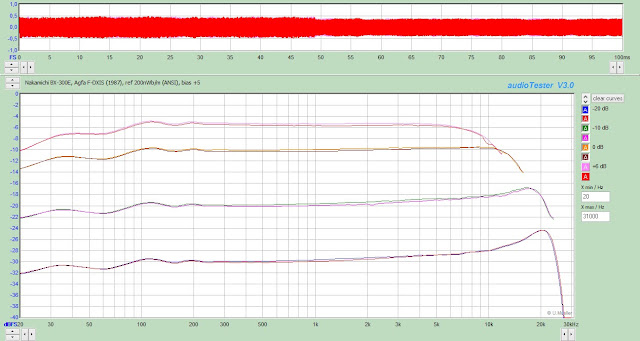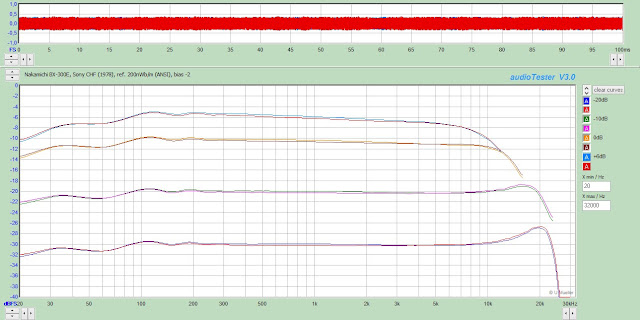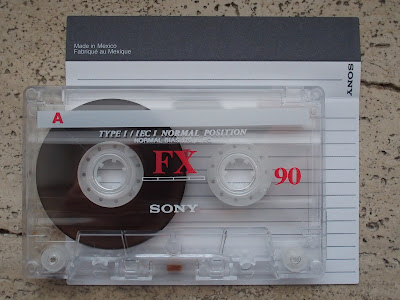This continues my evaluation of old cassette tapes, using my Nakamichi BX-300E
deck and Audiotester software. This time a bunch of entry-level Agfa ferrics
spanning three decades. You can find the equivalents from Maxell here, and from TDK here. And then there is of course the brand-new Recording The Masters Fox ferric.
For details on the measurement method look here.
Maxell UR (1994) (what the deck was calibrated for)
Relative bias: (reference)Relative sensitivity: (reference)
THD @ Dolby level: 0.42%
MOL400(THD=1%): +3.4dB
MOL400(THD=3%): +5.3dB
MOL1k(THD=3%): +2.9dB
SOL10k: -1.3dB
Bias noise: -49.5dB, -52.5dB(A)
Dynamic range: 57.8dB
Concerning sensitivity at 400Hz this UR seems a close match for the 1981 and 1994 IEC I references. At 10kHz UR sits between the old and the new reference. Also see my comments with the various BASF tapes below.
Agfa Low Noise (1972)
Relative bias: -5Relative sensitivity: -1.6dB
THD @ Dolby level: 5.4%
MOL400(1%): -6.0dB
MOL400(3%): -2.0dB
Bias noise: -50.1dB, -52.8dB(A)
Dynamic range: 50.8dB
This is one of the oldest tapes in my collection, first-generation with respect to its compatibility parameters. Noise is surprisingly good, but the tape cannot take modern levels. You may want to compare this with BASF LH.
Agfa Super High Dynamic (1972)
Relative bias: -2.5
Relative sensitivity: -1.2dB
THD @ Dolby level: 3.0%
MOL400(1%): -3.8dB
MOL400(3%): 0.0dB
MOL1k(3%): 0.0dB
SOL10k: -3.4dB
Bias noise: -48.1dB, -50.9dB(A)
Dynamic range: 50.9dB
Both MOL and noise increase relative to the Low Noise variant, returning the same dynamic range. But compatibility is closer to modern-day variants.
Agfa Ferrocolor (1979)
Relative bias: -2Relative sensitivity: 0dB
THD @ Dolby level: 0.85%
MOL400(1%): +0.5dB
MOL400(3%): +3.7dB
MOL1k(3%): +2.5dB
SOL10k: -2.4dB
Bias noise: -48.0dB, -51.1dB(A)
Dynamic range: 54.8dB
Surprisingly performant, this tape easily betters contemporary D and UL. Allegedly not an original Agfa, but made by Saehan.
Agfa Superferro (1979)
Relative bias: -3Relative sensitivity: -0.3dB
THD @ Dolby level: 1.7%
MOL400(1%): -1.5dB
MOL400(3%): +1.6dB
MOL1k(3%): +0.9dB
SOL10k: -2.2dB
Bias noise: -49.0dB, -52.1dB(A)
Dynamic range: 53.7dB
Remarkably inferior to the cheaper Ferrocolor.
Agfa FeI Ferrocolor HD (1982)
Relative bias: -3Relative sensitivity: -0.1dB
THD @ Dolby level: 1.6%
MOL400(1%): -1.1dB
MOL400(3%): +1.9dB
MOL1k(3%): +1.7dB
SOL10k: -2.2dB
Bias noise: -48.6dB, -51.5dB(A)
Dynamic range: 53.4dB
Although nearly mint and despite me trying to even it out this sample persisted in packing its tape very badly. There must have been invisible wear, because I had to reduce bias a lot to get a decent treble response. This resulted in the bad MOL figures seen above. The same tape under the HEMA brand performed much better.
Agfa FeI-S Superferro HDX (1982)
Relative bias: +5Relative sensitivity: -1.6dB
THD @ Dolby level: 1.4%
MOL400(1%): -1.4dB
MOL400(3%): +2.5dB
MOL1k(3%): +2.3dB
SOL10k: -0.2dB
Bias noise: -50.6dB, -54.3dB(A)
Dynamic range: 56.8dB
Welcome to the Twilight Zone! This tape threw me off initially. With type I bias maxed out the treble was still not flat. The tape being black I thought someone might have replaced it with chrome, but no, type II bias at minimum position gave -3dB at 10kHz. A bit of research revealed that this is a magnetite (Fe3O4) formula. Magnetite was pioneered by the TDK ED in 1973, but only appeared sporadically in cassettes until the early 90s, when it went more mainstream with the later generations of Maxell XLII and XLII-S.
The HDX's absurd compatibility parameters, the low MOL, and an unseen multitude of dropouts made me think that this was the result of bad ageing. Yet the cassette and tape, from my wife's collection, looked like new.
German magazine Audio April 1983 reviews this tape as quite good, also when operated in the IEC1 bias point. Hi-Fi Choice 1983 puts the bias in the 'slightly low' category, but agrees with my findings of low sensitivity, rising treble, low noise, and poor stability and dropouts. Hi-Fi Choice 1986, however, comments on the 'oddity of poor compatibility' and 'unusually poor overload headroom plus excessive treble'. It appears that my sample is the 1985-1986 version of the tape in the 1982-1985 shell. Given the taping history of my wife it is quite pla
usible that this one was purchased late in the product's life cycle. What remains is the question of how a manufacturer could unleash such a weird cassette on a market that at the time was predominantly following IEC guidelines. Superferror would have been a more apt name!
Agfa Ferrocolor HD (1984)
Relative bias: -2Relative sensitivity: -0.1dB
THD @ Dolby level: 0.85%
MOL400(1%): +0.3
MOL400(3%): +3.5dB
MOL1k(3%): +2.7dB
SOL10k: -1.6dB
Bias noise: -48.7dB, -51.9dB(A)
Dynamic range: 55.4dB
Agfa Superferro HDX (1984)
Relative bias: +5Relative sensitivity: -2.9dB
THD @ Dolby level: 2.3%
MOL400(1%): -2.6dB
MOL400(3%): +1.1dB
MOL1k(3%): +1.1dB
SOL10k: -2.1dB
Bias noise: -51.6dB, -55.8dB(A)
Dynamic range: 56.9dB
Agfa F-DXI (1987)
Relative bias: +0.5Relative sensitivity: -0.3dB
THD @ Dolby level: 0.55%
MOL400(1%): +2.2dB
MOL400(3%): +5.1dB
MOL1k(3%): +3.1dB
SOL10k: -1.5dB
Bias noise: -48.2dB, -51.5dB(A)
Dynamic range: 56.6dB
Agfa F-DXIS (1987)
Relative bias: > +5Relative sensitivity: -2.1dB
THD @ Dolby level: 1.4%
MOL400(1%): -1.0dB
MOL400(3%): +2.2dB
MOL1k(3%): +2.3dB
SOL10k: +1.1dB
Bias noise: -50.8dB, -54.6dB(A)
Dynamic range: 56.8dB
This Agfa has the reputation of having some of the lowest bias noise of any super ferric. It is based on magnetite, and just like the FeI-S above it requires an outrageously-high bias to flatten its response. In fact the BX-300 could not reach there, so the above measurement results were made in an underbiased state.
Yes, noise is pretty close to the best TDK AD/AR and Maxell UDIs, but MOL is very low, this tape ending up with the same dynamic range as its cheaper sibling. Correct biasing will increase MOL somewhat, but probably not much more than a dB or so. SOL is phenomenal, in metal class, but again, this is in part due to underbiasing. These figures are more or less confirmed in the What Hi-Fi 1987 tape special.
In my CR-7, whose calibrator sets bias to get a slightly higher level at 15kHz than at 400Hz this tape gives a more or less flat response at -20dB, albeit with a curious 1dB bump centered at 3kHz. MOL rises to +3.5dB and +4.1dB for 400Hz and 1kHz respectively, but SOL drops deep to -1.8dB, without question a consequence of the very high bias used to flatten the curve.
As we are used by now from Agfa: a tape with problematic compatibility.
Agfa HR-XS (1989)
Relative bias: 0Relative sensitivity: +0.2dB
THD @ Dolby level: 1.4%
MOL400(1%): +2.9dB
MOL400(3%): +5.6dB
MOL1k(3%): +3.4dB
SOL10k: -1.0dB
Bias noise: -51.1dB, -54.8dB(A)
Dynamic range: 60.4dB
Allegedly HR-XS came loaded with two tapes: Maxell XLI-S or BASF Ferro Maxima I. As this one's colour is darker than my XLI-Ss, it must be the latter ... Then again, it does not even remotely match my 1988 Maxima I sample!
INDEX OF ALL CASSETTES






























































